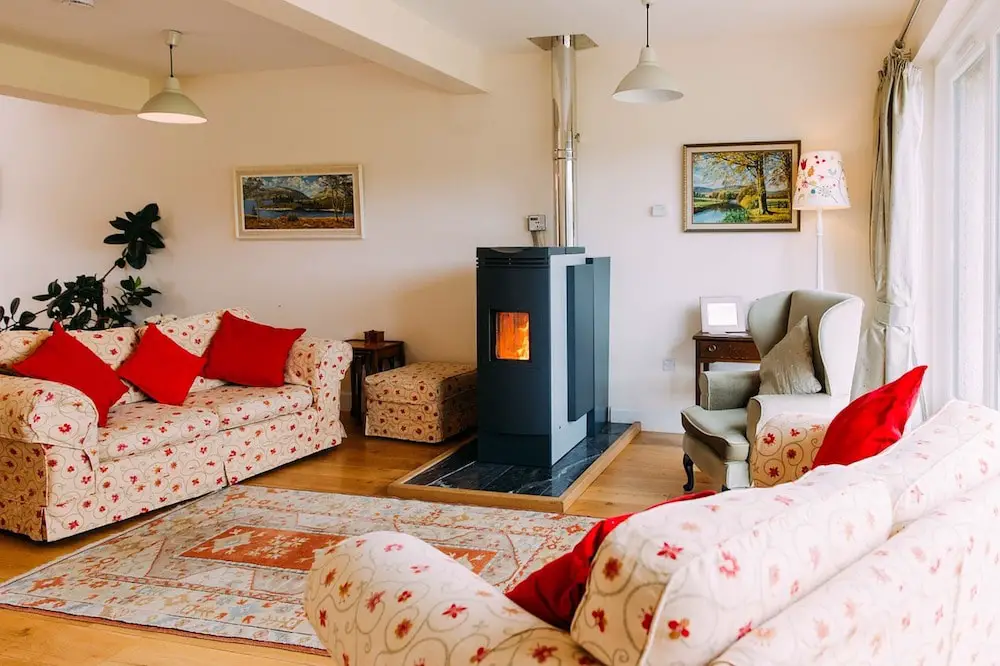Wood-burning stoves are a popular option for homeowners as they provide heat to your home. This heating option can save you money with heating costs and tends to be more fuel efficient than the typical fireplace. So, if you want to install one, how much would a wood stove increase your home insurance?
Homeowners insurance companies view wood stoves as a risk. This is because they house live fires inside the dwelling structure. This increases the risk of a fire inside the home, therefore increasing your overall risk and ISO rating when being assessed by the insurance agency. Some insurance companies will charge a flat fee for a wood stove, while other insurance agencies will increase your premium by up to 10%.

Every home insurance company is different. It is hard to say exactly how much a wood stove will increase your annual premium as it is dependent on the home, the company, and the location. Continue reading to learn more about how a wood stove could potentially affect your homeowner’s insurance policy.
- Professionally installed wood stoves that are up to code are covered by homeowners insurance
- Wood stoves may increase your annual homeowner’s insurance premium slightly
- Your wood stove may require an inspection from a WETT inspector before it is covered
Requirements to be covered with a wood burning stove
Before your insurance company will consider you to be insured under their policy, they must first ensure you meet the basic requirements with your wood stove. These requirements revolve around safety and installation.
An inspection may be required or requested by the insurance company before they insure you. This is to ensure that your wood stove was installed appropriately and that there is no further risk due to faulty installation.
The type of inspector required for this is called a WETT inspector. They will review your wood stove for the following:
- Ensure it complies with building codes
- Ensure it meets all safety requirements
- Ensure there is a chimney
- Ensure there is a flue pipe
- Check clearance requirements
- Look for a floor protector around the wood stove
If you are not required to have an inspection, then proof of professional installation may be required. If you did it as a DIY project, then proof of local inspection from a building code enforcement officer may be required to acquire coverage.
Wood stove certification
In order to make sure that your wood stove is safe to use for the home and insurable, it needs to be installed and inspected by a WETT-certified technician. When a wood stove passes the certification tests, it is easier to get the home insured. The certification is necessary to guarantee that the wood stove is installed safely and can operate with high efficiency.
It is important that the wood stove is able to meet the standard code to prevent issues with ventilation. It is also vital to check the minimum clearance on all sides to prevent the breakout of fire. Without this inspection, wood stoves may be able to cause fire due to overheating of combustible materials. Alternatively, one can also install a commercial shield or an air-cooled radiation shield.
Some homeowners opt to install a wood stove themselves. This seems to be a cheaper option, but it is important to be able to follow the requirements that need to be met for the installation of the wood stove. Even if the installation of the wood stove is DIY, it is essential to get a professional inspection for the wood stove in your home. This will help prevent any issues with your insurance provider.

Is smoke damage from a wood stove covered?
If you maintain your wood stove and ensure there are no blockages or hazards, and a chimney fire breaks out and causes smoke damage in your home, your homeowners insurance will likely cover the cost to mediate the problem. This is because smoke is a covered peril in most insurance policies.
However, if the wood stove is not properly maintained and cared for, and a fire or smoke causes damage to the home, your insurance company may deny the claim. Insurance companies will not cover perils that occur due to normal wear and tear or negligence. If you do not maintain your wood stove, this is considered negligence in most cases.
What about pellet stoves?
Pellet stoves are looked at in a similar manner as wood stoves. Because pellet stoves burn live fires, they cause a greater risk to a home and can increase your ISO rating, which will result in a higher annual premium. These pellet stoves often are required to be installed by a professional and inspected before the insurance agency covers them.
Many people argue that pellet stoves are safer since they are less likely to produce a spark when burning pellets. While this may be the case, your homeowner’s insurance will likely still require you to meet specific requirements and possibly pay more to cover the stove.

Wood stove risks and dangers
- Increase the chance of fire – This seems to be an obvious risk that is faced by most homes with an installed wood stove. There is a chance that the wood stove might overheat and burn any combustible materials in the vicinity, which can then lead to a fire.
- Health risks – Constant and frequent exposure can lead to several health risks. There are people that carry a higher risk, especially if they aren’t in the best of health. People with chronic illnesses or heart or lung diseases carry a higher risk of developing sicknesses related to smoke. Moreover, children and elders are also prone to contracting illnesses since their lungs are weaker.
- Air pollution – Since wood stoves produce toxic gases, they are releasing pollutants into the air. Exposure to air pollution may weaken one’s lungs and heart. Moreover, it may also cause chronic illnesses in the long run. There are also some short-term effects of frequent exposure to wood stove smoke like asthma attacks, carbon monoxide poisoning, and acute bronchitis.
Wood stove safety
As we have discussed earlier, it is important to have a WETT-Certification tag for your wood stove. This is because certified wood stoves are safe to use and can minimize the risks posed by the mere presence of wood stoves in your home. Apart from this, it is important to follow the requirements regarding the installation of wood stoves in your home. You can also use heat shields to add a layer of safety.
This is why it is vital to check the certification for the wood stove when you move into a new home. On the other hand, if you plan to install a new wood stove in your home, you should get a WETT Certificate and a Solid Fuel Heating Questionnaire.
Minimizing the risk of wood stoves
If you own a wood stove, it is important to minimize the risk associated with it. This means you should properly maintain the stove, have regular inspections of the stove, and use the right type of wood.
It is also important to keep the wood stove away from easily combustible or flammable items. This will help reduce the possibility of a fire breaking out inside the home. Keep your chimney clean and your flue clear, too, to avoid smoke backup and chimney fires.
Keep warm with your wood stove
Homeowner’s insurance will cover your wood stove if it is properly installed. The additional cost to insure a wood stove is often minor compared to the overall cost of an annual insurance premium. These stoves are efficient and great ways to offset heating costs. Don’t let the insurance premium scare you away.


hello my name is jerry smith im looking for house insurance for my home, i have a wood stove and its hard to find insurance co. maybe you can help.